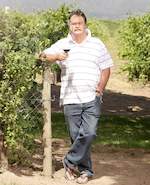Jacques Borman was doing great things with shiraz in the 1980s, long before it was fashionable in the Cape Winelands. And it remains his first love at Boschkloof, his farm on a Polkadraai hilltop near Stellenbosch.
Vintage 28

In recent years he's been developing a shiraz-driven blend, continuing experimental work on fermenting his Shiraz grapes with the skins of viognier, the white grape traditionally used in the Rhône to add that little bit extra to their reds.
When the designer working on his Boschkloof label asked the master blender what makes him so passionate about wine, he was told: 'I go to bed at night with the smell and the taste of the ultimate wine I want to make in my head. I haven't yet managed to find exactly what it is.' The imperturbably placid, moustached vintner pauses for a long moment: 'Will I ever? Well, I'll never stop trying.'
The designer returned a few days later with an elegant, classical cream label bearing a gold chalice, Jacques' 'holy grail', beneath which is inscribed the Latin inconcessum persequor: in search of the unattainable.
Despite the classicism and the philosophical bent, Jacques Borman is as down-to-earth as they come; 'plat op die aarde' as in his home tongue, Afrikaans. He is not prone to pretension or pretence and is honest to a fault.
'That great shiraz I used to make at La Motte? It was actually a freak of nature. It came from a vineyard that had everything wrong about it: the wrong clone, planted in the wrong soils, on the wrong slope, in the wrong bloody area! But it produced the most outstanding wine for all the time I was there. And that’s how I got into shiraz: discovering what great wine the grape could make from those old vines.'
He points out that it was a time when red varieties were largely untested in the Franschhoek Valley, then better known for its white wines, and new sites were experimental. 'A few years ago, about 90 percent of all Shiraz vines were younger than 10 years. It's one of the oldest varieties in the Cape, but was never vinified commercially.'
Jacques spent 19 vintages - from 1984 to 2003 - at the historic Franschhoek wine farm owned by Hanneli Koegelenberg, a member of the Rupert family whose late patriarch Dr. Anton Rupert also bought and restored nearby L'Ormarins. Jacques was involved in the initial development of La Motte, including the farm's organic vineyards on Nabot near Bot River.
There was also a fourth property: Rupert & Rothschild, a joint venture with French chateau owner Baron Edmond de Rothschild. As director of Rupert & Rothschild from 1997 to 2003, Jacques worked with Bordeaux-based oenologist Michel Rolland, renowned as an international consultant. Although Jacques is invariably associated with shiraz, he is also an acclaimed producer of Bordeaux-style blends, launching La Matte's award-winning Millennium.
He has since followed it up with his own Boschkloof Conclusion, a Guild auction regular. 'I happened to read an address by a scientist on the Internet in which he said: "My conclusion is that the whole is greater than the sum of its parts".' And to Jacques, that's what a blend is all about.
'I'd always wanted to do my own thing, right from the start,' says the would-be architect. He studied art at school - a still life with wine bottle and corkscrew in acrylic hangs in his sitting room. 'I'd like to get back to it sometime.'
After matriculating at Jan van Riebeeck High School in Cape Town, he was intent on enrolling at the University of Cape Town's faculty of architecture. 'My dad thought it a too liberal environment, so as a kind of rebellion I thought I'd go to the other end of the spectrum and be a farmer! I went to Elsenburg Agricultural College in Stellenbosch to study viticulture and pomology!'
Grape growing was part of the course and 'after getting into the whole wine vibe in Stellenbosch and loving it' he changed to viticulture and cellar technology. He then worked at Simonsig under veteran vintner and Cape Wineland's pioneer, the late Frans Malan, who with winemaker son Johan are renowned for taking in young talent to assist in ongoing experimentation across a spectrum of varieties and wines.
In a way, wine brought him and his wife Marina together. They met just after he'd left school: she was just 16 and he 19. 'It was a "blind date" with someone called "Borries",' she laughs. 'I actually thought l was going out with his brother because they had the same nickname!'
They went their separate ways until meeting up again in Stellenbosch: on the Elsenburg carnival float where Marina was among the group of girls called upon to be part of the street procession. We were very festive; there was a lot of wine on that float!'
 Chicken à la King recipe by Jacques Borman served with white rice and paired with Boschkloof Chardonnay wine....
Chicken à la King recipe by Jacques Borman served with white rice and paired with Boschkloof Chardonnay wine.... Curried lamb neck with fruit recipe by Jacques Borman paired with Boschkloof Syrah wine....
Curried lamb neck with fruit recipe by Jacques Borman paired with Boschkloof Syrah wine....